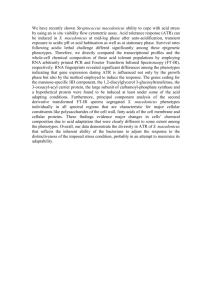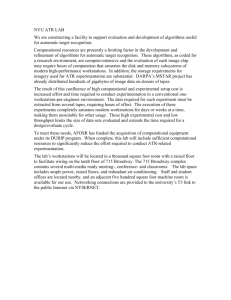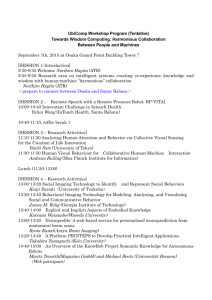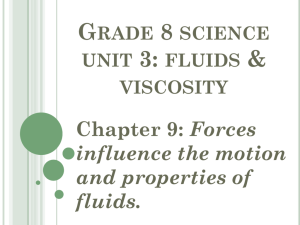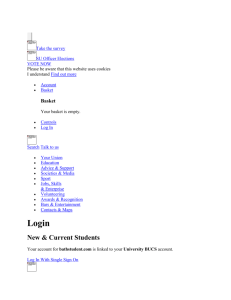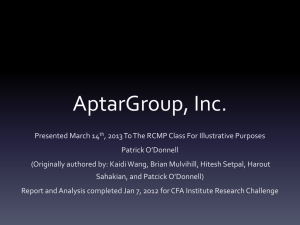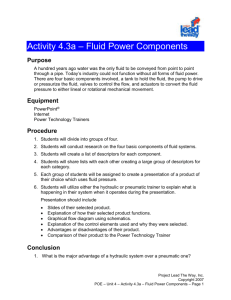OSU-HMFTF-997004-TECH-001
advertisement
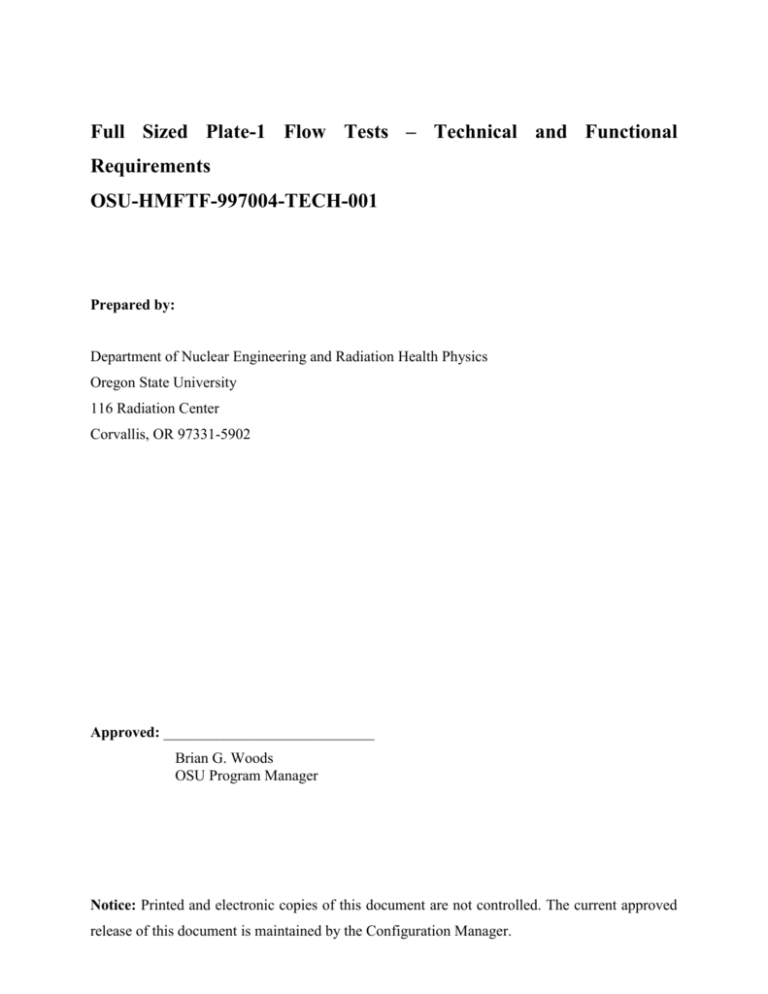
Full Sized Plate-1 Flow Tests – Technical and Functional Requirements OSU-HMFTF-997004-TECH-001 Prepared by: Department of Nuclear Engineering and Radiation Health Physics Oregon State University 116 Radiation Center Corvallis, OR 97331-5902 Approved: ____________________________ Brian G. Woods OSU Program Manager Notice: Printed and electronic copies of this document are not controlled. The current approved release of this document is maintained by the Configuration Manager. Tech. Report Number: OSU-HMFTF-997004-TECH-001 Revision: 0 Addendum: 0 Yes No Quality Document: Tech. Report Title: Full Sized Plate-1 Flow Tests – Technical and Functional Requirements Purpose: The purpose of this document is to describe the technical and functional requirements of the flow tests to be performed in the Oregon State University (OSU) Hydro-Mechanical Fuel Test Facility (HMFTF) on the Full Sized Plate-1 test element. Out-of-pile flow testing of each geometric configuration that is intended for experimental insertion into the Advanced Test Reactor (ATR) is intended to be performed as a part of the integrated design process of such an experiment. The purpose of these tests is to confirm design calculations and related aspects that are important to maintaining intended experiment operation. Affected Document(s): -Prepared By: Signature Date Signature Date Signature Date Wade R. Marcum Reviewed By: Aaron Weiss Approved By: Brian G. Woods 2 of 16 Technical Report: OSU-HMFTF-997004-TECH-001 Rev. 0 Prepared By: Wade Marcum Reviewed By: Aaron Weiss Add. 0 Sheet 3 of 16 Date: Date: Prepared for the U.S. Department of Energy Office of NNSA/NA-23 Material Management and Minimization Under DOE Idaho Operations Office Contract DE-AC07-05ID14517 DISCLAIMER This information was prepared as an account of work sponsored by an agency of the U.S. Government. Neither the U.S. Government nor any agency thereof, nor any of their employees, makes any warranty, express or implied, or assumes any legal liability or responsibility for the accuracy, completeness, or usefulness of any information, apparatus, product, or process disclosed, or represents that its use would not infringe privately owned rights. References herein to any specific commercial product, process, or service by trade name, trademark, manufacturer, or otherwise, does not necessarily constitute or imply its endorsement, recommendation, or favoring by the U.S. Government or any agency thereof. The views and opinions of authors expressed herein do not necessarily state or reflect those of the U.S. Government or any agency thereof. 3 of 16 Technical Report: OSU-HMFTF-997004-TECH-001 Rev. 0 Prepared By: Wade Marcum Reviewed By: Aaron Weiss Add. 0 Sheet 4 of 16 Date: Date: RECORD OF REVISIONS Revision Number - Effective Date Changes Initial Release 4 of 16 Approval Technical Report: OSU-HMFTF-997004-TECH-001 Rev. 0 Prepared By: Wade Marcum Reviewed By: Aaron Weiss Add. 0 Sheet 5 of 16 Date: Date: TABLE OF CONTENTS Section 1 Page INTRODUCTION .................................................................................................................. 8 1.1 PURPOSE 8 1.2 SCOPE 9 2 EMIPRE CHOPPED DUMMY IN-PILE TUBE EXPERIMENT DESCRIPTION .............. 9 3 FUEL ELEMENT FLOW TEST REQUIREMENTS .......................................................... 12 3.1 EMPIRE-CDIPT INTEGRATED DESIGN REQUIREMENTS 13 3.2 EMPIRE-CDIPT-1 (STRUCTURAL AND HYDRAULIC CHARACTERIZATION TEST) 14 4 SUMMARY .......................................................................................................................... 16 5 REFERENCES ..................................................................................................................... 16 5 of 16 Technical Report: OSU-HMFTF-997004-TECH-001 Rev. 0 Prepared By: Wade Marcum Reviewed By: Aaron Weiss Add. 0 Sheet 6 of 16 Date: Date: LIST OF FIGURES Figure Page Figure 1: Isometric breakdown of the EMPIRE-CDIPT Composition ......................................... 10 Figure 2: Sketch of the in-vehicle arrangement of components within EMPIRE-CDIPT ........... 11 LIST OF TABLES Table Page Table 1: Fuel Element Safety Basis Requirements ....................................................................... 13 Table 3: EMPIRE-CDIPT Integrated Flow Test (EMPIRE-CDIPT-1) ........................................ 14 6 of 16 Technical Report: OSU-HMFTF-997004-TECH-001 Rev. 0 Prepared By: Wade Marcum Reviewed By: Aaron Weiss LIST OF ACRONYMS ATR Advanced Test Reactor FSP Full Sized Plate HEU Highly Enriched Uranium HMFTF Hydro-Mechanical Fuel Test Facility HPRR High Performance Research Reactor INL Idaho National Laboratory LEU Low Enriched Uranium NNSA National Nuclear Security Administration OSU Oregon State University T&FR Technical and Functional Requirement 7 of 16 Add. 0 Sheet 7 of 16 Date: Date: Technical Report: OSU-HMFTF-997004-TECH-001 Rev. 0 Prepared By: Wade Marcum Reviewed By: Aaron Weiss 1 Add. 0 Sheet 8 of 16 Date: Date: INTRODUCTION The Convert branch of the National Nuclear Security Administration (NNSA) is working to develop high uranium density fuels for research and test reactors. These fuels are intended to enable conversion from highly enriched uranium (HEU) based fuel to low enriched uranium (LEU) based fuel for U.S. and European high performance research reactors (HPRR). The development of the high uranium density fuels for the research reactors has been centered on several objectives; although the enrichment of Uranium 235 is reduced in the LEU fuel, it is desired to maintain equal reactor performance characteristics while meeting all safety requirements. With this in mind, two fuel designs are being developed around a uranium molybdenum alloy fuel phase: a dispersion and a monolithic version. The Full Sized Plate-1 (FSP-1) will be irradiated at the INL's Advanced Test Reactor (ATR) to test the irradiation performance of fueled plates. The hydraulic characterization tests of the holders and vehicles that will be used to irradiate the FSP-1 plates are the subject of this effort. 1.1 Purpose Out-of-pile flow testing of representative geometric configurations intended for experimental insertion into the ATR will be performed as a part of the integrated design process of such an experiment. The purpose of these tests is to calibrate, validate, and verify design and hydraulic calculations for the experiment. The requirements of the experimental flow tests identified herein include: 1. Verify that the integrity of experimental hardware and its configuration is not compromised under anticipated in-pile hydraulic loads. 2. Provide experimental data to: a. Quantify hydraulic characteristics of the experiment, which may be used to update experiment calculations b. Quantify the transient response of experiment hardware to expected hydraulic loads and boundary conditions 3. Potentially identify phenomena that were not identified during design and calculation process. 8 of 16 Technical Report: OSU-HMFTF-997004-TECH-001 Rev. 0 Prepared By: Wade Marcum Reviewed By: Aaron Weiss 1.2 Add. 0 Sheet 9 of 16 Date: Date: Scope The Technical and Functional Requirements (T&FRs) defined herein describe flow testing with respect to the FSP-1 geometric configuration that is intended to be placed in the ATR. This representative geometry has been designed by the Idaho National Laboratory (INL) and reviewed so as to minimize differences between out-of-pile flow test geometry and in-pile reactor geometry. 2 FULL SIZED PLATE-1 EXPERIMENT DESCRIPTION The FSP-1 experimental vehicle, also referred to as the “Full Sized Plate-1” is designed to facilitate in-pile testing of various test plates within flux trap locations of the ATR which can be configured appropriately for the vehicle to be placed within. These irradiation test programs are driven to yield appropriate fluence levels on each fueled experiment to support the development of the uraniummolybdenum alloy fuel. The vehicle comprises four main components (shown in Figure 1 and Figure 2): Flow Simulator – The Flow Simulator is a cylindrical body with an outer diameter of nominally 6 inches, an inner diameter of 5.25 inches and a total length of 74.88 inches. The Flow Simulator is the interfacing component between the Hydro-Mechanical Fuel Test Facility (HMFTF) and the remaining components which comprise the FSP-1. The inner geometry of the Flow Simulator is designed to reflect similar conditions found within the ATR. Outer Basket – The Outer Basket is the outer-most geometry which will be placed within the ATR. The Outer Basked has an outer diameter of 5.13 inches, an inner diameter of 4 inches, and is 66.92 inches in length. An Orifice Plate is located on the lower most surface of the Outer Basket. Use of an appropriately sized orifice plate will lead to the desired hydraulic balance (flow rate and pressure drop) that satisfies safety bases and in-pile irradiation conditions. The Orifice Plate is secured to the outer basked via 6 socket head cap screws. Inner Basket – The Inner Basket acts as a holder for the Test Plates. The Inner Basket has an outer diameter of 3.88 inches and a total length of 65.45 inches. The interior of the Inner Basket has been machined to a square slot to provide a mating surface to for the Test Plates. The Inner Basked comprises two assemblies; the top region is the Handle Assembly which 9 of 16 Technical Report: OSU-HMFTF-997004-TECH-001 Rev. 0 Prepared By: Wade Marcum Reviewed By: Aaron Weiss Add. 0 Sheet 10 of 16 Date: Date: is connected to the Body Assembly via a hinge point. This hinge allows for the rotation of the Handle Assembly to be placed out of concentricity with the Body Assembly which provides sufficient space for the Test Plates to be slid into their appropriate location. Test Plates & Ram Rod – Six Test Plates are located in the FSP-1. These Test Plates all have a width of 2.24 inches (2.40 inches including the side rail), thickness of 0.05 inches (0.25 inches including the side-rail), and a length of 48.75 inches nominally. These plates are placed adjacent to one another inside the square slot that is located within the Inner Basket. They are held secure in-place via a Ram Rod. The Ram Rod is a 0.725 inch thick aluminum square plate which is placed between the outer-most Test Plate and the inner surface of the Inner Basket. The Ram Rod provides mechanically secures the Test Plates both horizontally and vertically within the Inner Basket through a compression fit against the plates’ side-rails). The outer primary surface of the Ram Rod contains a number of ball plungers which compress the Ram Rod against the side rails of the Test Plates, securing them horizontally. The Test Plates are secured vertically by a small arm located on the top of the Ram Rod which mates against the top surface of each test plate’s side rail. Flow Simulator Outer Basket Inner Simulator Test Plates & Ram-Rod Figure 1: Isometric breakdown of the FSP-1 Composition 10 of 16 Technical Report: OSU-HMFTF-997004-TECH-001 Rev. 0 Prepared By: Wade Marcum Reviewed By: Aaron Weiss Add. 0 Sheet 11 of 16 Date: Date: Flow Simulator Outer Basket Handling Bracket Inner Basket Ram Rod Test Plates (1 – 6) Test Plate Flow Inlet Region Test Plate Flow Outlet Region Orifice Plate Flow Adaptor Orifice Plate Flow Outlet Region Figure 2: Rendering of the basket arrangement of components within FSP-1 11 of 16 Technical Report: OSU-HMFTF-997004-TECH-001 Rev. 0 Prepared By: Wade Marcum Reviewed By: Aaron Weiss 3 Add. 0 Sheet 12 of 16 Date: Date: FUEL ELEMENT FLOW TEST REQUIREMENTS The technical and functional requirements FSP-1 flow tests are based on the integrated design requirements. Section 3.1 describes the bases for integrated design requirements of the FSP-1 for which flow test needs were identified. The Hydraulic Characterization Test is intended to provide an objective assessment of the hydraulic traits associated with the geometry of FSP-1. These traits include aspects of flow distribution within the length of the vehicle along with the overall bulk response of the test apparatus such as pressure drop versus flow rate. The bases identified for this test are satisfied by exposing the experimental geometry to a constant inlet pressure and temperature while varying flow rate at small increments over the entire operating range to which the vehicle will be exposed under irradiation within the ATR core. The Structural Response Characterization Test is intended to provide an objective assessment of the rigid-body vibratory response associated with the geometry of FSP-1 as may be observed within the ATR. This response is intended to be captured under similar experimental controls as that of the Hydraulic Characterization Test with the use of accelerometers located strategically on the FSP-1 geometry so as to facilitate the acquisition of mechanical vibration of the experimental device while being exposed to various hydraulic flow conditions. 12 of 16 Technical Report: OSU-HMFTF-997004-TECH-001 Rev. 0 Prepared By: Wade Marcum Reviewed By: Aaron Weiss 3.1 Add. 0 Sheet 13 of 16 Date: Date: FSP-1 Integrated Design Requirements # Table 1: Functional Requirements Test Title Description FSP-1-1 Hydraulic Characterization Test Assess overall pressure drop across element as a function of flow. FSP-1-2 Structural Response Characterization Test Perform flow induced vibration tests to identify the presence of and possibly characterize vibration of experiment components such as plates, capsules or basket 13 of 16 Basis Satisfy Outcome 1 in Section 1.1 Satisfy Outcome 2 in Section 1.1 Satisfy Outcome 3 in Section 1.1 Technical Report: OSU-HMFTF-997004-TECH-001 Rev. 0 Prepared By: Wade Marcum Reviewed By: Aaron Weiss 3.2 Add. 0 Sheet 14 of 16 Date: Date: FSP-1 (Hydraulic Characterization Test) Element (justification) Configuration (justification) Table 2: FSP-1 Integrated Flow Test (FSP-1-1) Complete vehicle of equivalent in-pile form (Satisfies basis 1 and 2 identified in Table 1 for FSP-1-1) Test facility configured in down-flow configuration (representative of flow direction through ATR core) Control Variables [recommended quantity] (justification) Test element arranged to represent nominal in-pile geometry (as representative of flow distribution through ATR core as feasibly allowable) Test element inlet pressure [360 psig] (nominal inlet pressure of ATR core) Fluid temperature [150 °F] (ATR fluid temperature ranges from 125 to 175 °F across core) Fluid conductivity [ < 100 µS/cm] (minimize mineral interaction with clad material) Fluid pH [5.5] (minimize oxide layer growth rate on clad Flow rate [~250 gpm to 550 gpm] (span across entire operating condition of in-pile vehicle) Independent Variable [recommended range] (justification) Test type [Destructive, Non-destructive] (discussion) Non-destructive (pressure drop testing is intended to be nondestructive) Critical Measurements (plausible instrument selection) System pressure (pressure transmitter) Fluid temperature (thermocouple) Total net flow rate (vortex flow meter, annubar) Net pressure drop across element test section (2x pressure transmitters, differential pressure transmitter) Flow channel flow rate (total- and static-pressure pitot tubes) Bypass channel flow rate (vortex flow meter) Mechanical Vibration (accelerometer[s] located on the vehicle and housing) Fluid conductivity (fluid conductivity meter) Fluid pH (fluid pH meter) Supplemental Measurements (plausible instrument selection) 14 of 16 Technical Report: OSU-HMFTF-997004-TECH-001 Rev. 0 Prepared By: Wade Marcum Reviewed By: Aaron Weiss 3.3 Add. 0 Sheet 15 of 16 Date: Date: FSP-1 (Structural Response Characterization Test) Element (justification) Configuration (justification) Table 3: FSP-1 Integrated Flow Test (FSP-1-2) Complete vehicle of equivalent in-pile form (Satisfies basis 1 identified in Table 1 for FSP-1-2) Test facility configured in down-flow configuration (representative of flow direction through ATR core) Control Variables [recommended quantity] (justification) Test element arranged to represent nominal in-pile geometry (as representative of flow distribution through ATR core as feasibly allowable) Test element inlet pressure [360 psig] (nominal inlet pressure of ATR core) Fluid temperature [150 °F] (ATR fluid temperature ranges from 125 to 175 °F across core) Fluid conductivity [ < 100 µS/cm] (minimize mineral interaction with clad material) Fluid pH [5.5] (minimize oxide layer growth rate on clad Flow rate [~250 gpm to ~550 gpm] (span across entire operating condition of in-pile vehicle) Independent Variable [recommended range] (justification) Test type [Destructive, Non-destructive] (discussion) Non-destructive (pressure drop testing is intended to be nondestructive) Critical Measurements (plausible instrument selection) System pressure (pressure transmitter) Fluid temperature (thermocouple) Total net flow rate (vortex flow meter) Bypass channel flow rate (vortex flow meter) Net pressure drop across element test section (2x pressure transmitters, differential pressure transmitter) Mechanical Vibration (accelerometer[s] located on the vehicle and housing) Fluid conductivity (fluid conductivity meter) Supplemental Measurements (plausible instrument selection) Fluid pH (fluid pH meter) 15 of 16 Technical Report: OSU-HMFTF-997004-TECH-001 Rev. 0 Prepared By: Wade Marcum Reviewed By: Aaron Weiss 4 Add. 0 Sheet 16 of 16 Date: Date: SUMMARY This document has summarizes the flow test related requirements of the proposed EMPIRECDIPT geometry to be utilized within the ATR core. The necessities for an integrated flow test campaign that provides data to support the safety basis and design feedback of in-pile experiments to be inserted into the ATR have been described. This work is intended to establish an experimentally-grounded basis for the physical design and instrumentation needs of the EMPIRE-CDIPT flow test. 5 REFERENCES None. 16 of 16
